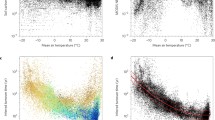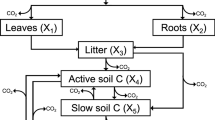Abstract
Since the decomposition rate of soil organic carbon (SOC) varies as a function of environmental conditions, global climate change is expected to alter SOC decomposition dynamics, and the resulting changes in the amount of CO2 emitted from soils will feedback onto the rate at which climate change occurs. While this soil feedback is expected to be significant because the amount of SOC is substantially more than the amount of carbon in the atmosphere, the environmental dependencies of decomposition at global scales that determine the magnitude of the soil feedback have remained poorly characterized. In this study, we address this issue by fitting a mechanistic decomposition model to a global dataset of SOC, optimizing the model’s temperature and moisture dependencies to best match the observed global distribution of SOC. The results of the analysis indicate that the temperature sensitivity of decomposition at global scales (Q 10=1.37) is significantly less than is assumed by many terrestrial ecosystem models that directly apply temperature sensitivity from small-scale studies, and that the maximal rate of decomposition occurs at higher moisture values than is assumed by many models. These findings imply that the magnitude of the soil decomposition feedback onto rate of global climate change will be less sensitive to increases in temperature, and modeling of temperature and moisture dependencies of SOC decomposition in global-scale models should consider effects of scale.
Similar content being viewed by others
References
Bachelet D, Lenihan JM, Daly C, Neilson RP, Ojima DS, Parton WJ (2001) MC1: A dynamic vegetation model for estimating the distribution of vegetation and associated ecosystem fluxes of carbon, nutrients and water. USDA Forest Service General Technical Report, PNW-GTR-508 1-95
Bellamy PH, Loveland PJ, Bradley RI, Lark RM, Kirk GJD (2005) Carbon losses from all soils across England and Wales 1978–2003. Nature 437:245–248
Bolker BM, Pacala SW, Parton WJ (1998) Linear analysis of soil decomposition: insights from the Century model. Ecol Appl 8:425–439
Bonan GB, Shugart HH (1989) Environmental-factors and ecological processes in boreal forests. Annu Rev Ecol Syst 20:1–28
Burke I, Kaye J, Bird S, Hall S, McCulley R, Sommerville G (2003) Evaluating and testing models of terrestrial biogeochemistry: the role of temperature in controlling decomposition. In: Canham C, Cole J, Lauenroth W (eds) Models in ecosystem science. Princeton Univ. Press, NJ, pp 225–253
Chimner RA, Welker JM (2005) Ecosystem respiration responses to experimental manipulations of winter and summer precipitation in a Mixedgrass Prairie, WY, USA. Biogeochemistry 73:257–270
Clymo RS (1984) The limits to peat bog growth. Philos Trans Royal Soc B 303:605–654
Cox P (2001) Description on the triffid dynamic global vegetation model. Technical Report 24. Hadley Centre Met Office, Devon UK
Cox PM, Betts RA, Jones CD, Spall SA, Totterdell IJ (2000) Acceleration of global warming due to carbon-cycle feedbacks in a coupled climate model. Nature 408: 184–187
Cramer W, Kicklighter DW, Bondeau A, Moore B, Churkina C, Nemry B, Ruimy A, Schloss AL (1999) Comparing global models of terrestrial net primary productivity (NPP): overview and key results. Global Change Biol 5(Suppl 1):1–15
Dai A, Fung IY (1993) Can climate variability contribute to the “missing” CO2 sink?. Global Biogeochem Cy 7:599–609
Dingman SL (2002) Physical hydrology, 2nd edn. Prentice Hall, Upper Saddle River, NJ
Edwards AWF (1992) Likelihood. John Hopkins University Press, Baltimore
Environment Canada (1995) The state of Canada’ s climate: monitoring change and variability. SOE Report No. 95-1 (p 52). Ottawa, Canada
Fang CM, Smith P, Moncrieff JB, Smith JU (2005) Similar response of labile and resistant soil organic matter pools to changes in temperature. Nature 433:57–59
Fierer N, Craine JM, McLauchlan K, Schimel JP (2005) Litter quality and the temperature sensitivity of decomposition. Ecology 86:320–326
Finlay BJ (2002) Global dispersal of free-living microbial eukaryote species. Science 296:1061–1063
Foley JA, Prentice IC, Ramankutty N, Levis S, Pollard D, Sitch S, Haxeltine A (1996) An integrated biosphere model of land surface processes, terrestrial carbon balance, and vegetation dynamics. Global Biogeochem Cy 10:603–628
Friedlingstein P, Delire C, Muller JF, Gerard JC (1992) The climate induced variation of the continental biosphere: a model simulation of the Last Glacial Maximum. Geophys Res Lett 19:897–900
Giardina CP, Ryan MG (2000) Evidence that decomposition rates of organic carbon in forest mineral soil do not vary with temperature. Nature 404:858–861
Gitz V, Ciais P (2004) Future expansion of agriculture and pasture acts to amplify atmospheric CO2 levels in response to fossil-fuel and land-use change emissions. Clim Change 67:161–184
Global Soil Data Task (2000) Global soil data products CD-ROM (IGBP-DIS). International Geosphere-Biosphere Programme – data and information services. Available online at [http://www.daac.ornl.gov/] from the ORNL Distributed Active Archive Center, Oak Ridge National Laboratory, Oak Ridge, TN
Gorham E (1991) Northern peatlands – role in the carbon-cycle and probable responses to climatic warming. Ecol Appl 1:182–195
Hansen J, Fung I, Lacis A, Lebedef S, Rind D, Ruedy R, Russel G, Stone P (1988) Global climate changes as forecast by the Goddard Institute for Space Studies three dimensional model. J Geophys Res 93:9341–9364
Holland EA, Neff JC, Townsend AR, McKeown B (2000) Uncertainties in the temperature sensitivity of decomposition in tropical and subtropical ecosystems: implications for models. Global Biogeochem Cy 14:1137–1151
Intergovernmental Panel on Climate Change (2001) Climate change 2001: the scientific basis. Available online at [http://www.grida.no/climate/ipcc_tar/]
Jobbagy EG, Jackson RB (2000) The vertical distribution of soil organic carbon and its relation to climate and vegetation. Ecol Appl 10:423–436
Jones CD, Cox PM, Essery RLH, Roberts DL, Woodage MJ (2003) Strong carbon cycle feedbacks in a climate model with interactive CO2 and sulphate aerosols. Geophys Res Lett 30:1479, doi:10.1029/2003GL016867
Jones C, McConnell C, Coleman K, Cox P, Falloon P, Jenkinson D, Powlson D (2005) Global climate change and soil carbon stocks; predictions from two contrasting models for the turnover of organic carbon in soil. Glob Change Biol 11:154–166
Kirschbaum MUF (1995) The temperature dependence of soil organic matter decomposition, and the effect of global warming on soil organic C storage. Soil Biol Biochem 27:753–760
Kerr JT, Cihlar J (2003) Land use and cover with intensity of agriculture for Canada from satellite and census data. Global Ecol Biogeog 12:161–172
Knorr W, Prentice IC, House JI, Holland EA (2005) Long-term sensitivity of soil carbon turnover to warming. Nature 433:298–301
Leifeld J, Fuhrer J (2005) The temperature response of CO2 production from bulk soils and soil fractions is related to soil organic matter quality. Biogeochemistry 75:433–453
Lieth H (1975) Modeling the primary productivity of the world. In: Lieth H, Whittaker RH (eds) Primary Productivity of the biosphere. Springer-Verlag, New York, pp␣237–263
Luo Y, Shiqiang W, Dafeng H, Wallace LL (2001) Acclimatization of soil respiration to warming in a tall grass prairie. Nature 413:622–625
Malmstrom VH (1969) A new approach to the classification of climate. J Geog 68:351–357
Manabe S, Wetherald RT (1987) Large scale changes in soil wetness induced by an increase in carbondioxide. J Atmos Sci 44:1211–1235
Melillo JM, Steudler PA, Aber JD, Newkirk K, Lux H, Bowles FP, Catricala C, Magill A, Ahrens T, Morrisseau S (2002) Soil warming and carbon-cycle feedbacks to the climate system. Science 298:2173–2176
Metherell AK, Harding LA, Cole CV, Parton WJ (1993) CENTURY soil organic matter model environment: technical documentation. Agroecosystem version 4.0. Great Plains System Res Unit Tech Report 4. USDA-ARS, Fort Collins, CO, USA
Metropolis N, Rosenbluth AW, Rosenbluth MN, Teller AH, Teller E (1953) Equations of state calculations by fast computing machines. J Chem Phys 21:1087–1091
Moorcroft PR, Hurtt GC, Pacala SW (2001) A method for scaling vegetation dynamics: the ecosystem demography model (ED). Ecol Monogr 71:557–585
New M, Hulme M, Jones PD (2000) Global 30-year mean monthly climatology, 1961–1990 data set. Available online [http://www.daac.ornl.gov] from Oak Ridge National Laboratory Distributed Active Archive Center, Oak Ridge, TN
Niklinska M, Maryanski M, Laskowski R (1999) Effect of temperature on humus respiration rate and nitrogen mineralization: implications for global climate change. Biogeochemistry 44:239–257
Parton WJ, Schimel DS, Cole CV, Ojima DS (1987) Analysis of factors controlling soil organic matter levels in Great Plains grasslands. Soil Sci Soc Am J 51:1173–1179
Parton WJ, Scurlock JMO, Ojima DS, Gilmanov TG, Scholes RJ, Schimel DS, Kirchner T, Menaut JC, Seastedt T, Moya EG, Kamnalrut A, Kinyamario JI (1993) Observations and modeling of biomass and soil organic-matter dynamics for the grassland biome worldwide. Global Biogeochem Cy 7:785–809
Parton W, Stewart J, Cole C (1988) Dynamics of C, N, P and S in grassland soils – a model. Biogeochemistry 5:109–131
Potter CS, Klooster SA (1997) Global model estimates of carbon and nitrogen storage in litter and soil pools: response to changes in vegetation quality and biomass allocation. Tellus B 49:1–17
Potter CS, Randerson JT, Field CB, Matson PA, Vitousek PM, Mooney HA, Klooster SA (1993) Terrestrial ecosystem production: a process model based on global satellite and surface data. Global Biogeochem Cy 7:811–841
Raich JW, Potter CS, Bhagawati D (2002) Interannual variability in global soil respiration, 1980–94. Glob Change Biol 8:800–812
Ramankutty N, Foley JA (1998) Characterizing patterns of global land use: an analysis of global croplands data. Global Biogeochem Cy 12:667–685
Scheffer RA, van Logtestijn RSP, Verhoeven JTA (2001) Decomposition of Carex and Sphagnum litter in two mesotrophic fens differing in dominant plant species. Oikos 92:44–54
Schimel DS, Braswell BH, Holland EA, McKeown R, Ojima DS, Painter TH, Parton WJ, Townsend AR (1994) Climatic, edaphic, and biotic controls over storage and turnover of carbon in soils. Global Biogeochem Cy 8:279–293
Schimel DS, Braswell BH, McKeown R, Ojima DS, Parton WJ, Pulliam W (1996) Climate and nitrogen controls on the geography and timescales of terrestrial biogeochemical cycling. Global Biogeochem Cy 10:677–692
Schlesinger WH (1997) Biogeochemistry, an analysis of global change. Academic Press, San Diego, CA
Schlesinger ME, Zhao ZC (1988) Seasonal climatic changes induced by doubled CO2 as simulated by the OSU atmospheric GCM/mixed layer ocean model. Climate Research Institute, Oregon State University, Corvallis, OR
Schulze ED, Freibauer A (2005) Carbon unlocked from soils. Nature 437:205–206
Stocks BJ, Fosberg MA, Lynham TJ, Mearns L, Wotton BM, Yang Q, Jin JZ, Lawrence K, Hartley GR, Mason JA, McKenney DW (1998) Climate change and forest fire potential in russian and canadian boreal forests. Clim Change 38:1–13
Trumbore S (2000) Age of soil organic matter and soil respiration: radiocarbon constraints on belowground C dynamics. Ecol Appl 10:399–411
Valentini R, Matteucci G, Dolman AJ, Schulze ED, Rebmann C, Moors EJ, Granier A, Gross P, Jensen NO, Pilegaard K, Lindroth A, Grelle A, Bernhofer C, Grunwald T, Aubinet M, Ceulemans R, Kowalski AS, Vesala T, Rannik U, Berbigier P, Loustau D, Guomundsson J, Thorgeirsson H, Ibrom A, Morgenstern K, Clement R, Moncrieff J, Montagnani L, Minerbi S, Jarvis PG (2000) Respiration as the main determinant of carbon balance in european forests. Nature 404:861–865
Yang X, Wang M, Huang Y, Wang Y (2002) A one-compartment model to study soil carbon decomposition rate at equilibrium situation. Ecol Model 151:63–73
Winkler JP, Cherry RS, Schlesinger WH (1996) The Q 10 relationship of microbial respiration in a temperate forest soil. Soil Biol Biochem 28:1067–1072
Acknowledgements
We appreciate the helpful comments from Professor Michael G. Ryan and Dr. Christian P. Giardina. The graduate study of Takeshi Ise is supported by the James Mills Peirce Fellowship provided by the Department of Organismic and Evolutionary Biology at Harvard University. Comments from anonymous reviewers have clarified the manuscript, and suggestions and discussions on the Q 10 concept and other fundamental assumptions are extremely valuable.
Author information
Authors and Affiliations
Corresponding author
Rights and permissions
About this article
Cite this article
Ise, T., Moorcroft, P. The global-scale temperature and moisture dependencies of soil organic carbon decomposition: an analysis using a mechanistic decomposition model. Biogeochemistry 80, 217–231 (2006). https://doi.org/10.1007/s10533-006-9019-5
Received:
Accepted:
Published:
Issue Date:
DOI: https://doi.org/10.1007/s10533-006-9019-5




